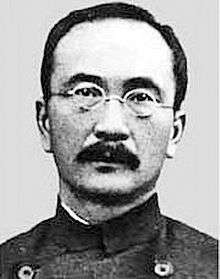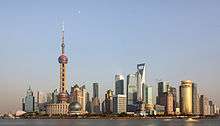Wukang Road
Wukang Road (Chinese: 武康路; pinyin: Wǔkāng Lù; Shanghainese: Wukon Lu), originally Route Ferguson (福开森路), is a historic road in the Xuhui District of Shanghai, China, located in the western part of the former French Concession area of the city.[1] In 2011 Wukang Road was recognized as one of the National Historic and Cultural Streets of China.[2]
Overview
Wukang Road is only 1.17 kilometres (0.73 mi) long, but is lined with 37 officially protected historic buildings.[3] The buildings in the road incorporate a diverse range of architectural styles, including Mediterranean, French Renaissance, English, and Art Deco.[4] The area is characterized by quiet streets lined with wutong (London plane) trees.[3] Well-known blogger Wang Jianshuo calls it his favourite street in Shanghai.[5] The buzz of recent café and restaurant openings along the road have drawn both local and international foodies and lifestyle bloggers, with many happily queuing more than an hour for a scoop of ice cream.[6]
In Ang Lee's 2007 film Lust, Caution, Route Ferguson is where the hero and heroine have their secret rendezvous.[4] The road is also featured in Chen Danyan's novel Shanghai Memorabilia.[3] It is a popular sightseeing location for tourists interested in the architecture and history of the area. There is a tourist information center at 393 Wukang Road that provides self-guided walking tours.[7]
History


In 1897, John Calvin Ferguson, an American educator and president of Nanyang Public School (predecessor of Shanghai Jiao Tong University), built the road with his own salary to make it easier for colleagues and students to get to the school.[8] The road was thus named Route Ferguson in his honour.[2][8] It was paved in 1907[4] and broadened by the government of the French Concession. It was renamed Wukang Road in 1943, after Wukang County (now part of Deqing) in nearby Zhejiang province, but its original name is still well known to locals.[8]
Wukang Road has been home for numerous Chinese celebrities, especially during the mid-20th century. Famous residents include revolutionary Huang Xing, first lady Soong Ching-ling, high-ranking politicians Zhou Fohai, Tang Shaoyi, Chen Lifu, Chen Guofu, Chen Yi, Deng Xiaoping, writers Ba Jin, Zheng Zhenduo, Li Shizeng, singer Zhou Xuan, and many movie stars and business tycoons.[3]
In 1937, Tang Shaoyi, the first prime minister of the Republic of China, bought a house on Route Ferguson (now at No. 1, Lane 40, Wukang Road) and retired there. The following year, the Imperial Japanese Army invaded and occupied Shanghai (though not yet the foreign concessions), and tried to recruit Tang to head a pro-Japanese puppet government. Fearing Tang may collaborate with the Japanese, the Kuomintang assassinated him at his home on 30 September 1938.[4][9]
Notable buildings
Wukang Mansion

The Wukang Mansion (formerly Normandie Apartments), at the southern end of Wukang Road, on the corner with Middle Huaihai Road, is a protected historic building. It was designed by the renowned Hungarian-Slovak architect László Hudec (1893–1958) in the French Renaissance style, and was completed in 1924.[10] It was home to numerous celebrities including famous actors and actresses Wu Yin, Wang Renmei, Qin Yi, Zhao Dan, Sun Daolin, Wang Wenjuan, Shangguan Yunzhu, and actor/director Zheng Junli.[11] Soong Ching-ling, the widow of President Sun Yat-sen, lived at the end of Wukang Road across Huaihai Road. Her home is now open to the public as the Soong Ching-ling Memorial Residence.[12]
Former residences
The road was the former residence for a number of notable people:[8]
- No. 2 : the Former Residence of Mo Shangqing, "silk czar".[13]
- Lane 40, No. 1: the Former Residence of Tang Shaoyi, politician.
- Lane 40, No. 4: the Former Residence of Yan Fuqing, academic.
- No. 67: the Former Residence of Chen Lifu, politician.
- No. 99: the Former Residence of the British executive of the Zhengguanghe beverage company.
- Lane 107, No. 2: the Former Residence of Chen Guofu, politician.
- No. 113: the Former Residence of the writer Ba Jin (1904–2005). The house was originally built in 1923 in Spanish style. Ba Jin lived there from 1955. The residence was opened to the public in December 2011.[14][15]
- Lane 117, No. 1: the Former Residences of Zhou Zuomin (1882–1955), banker.
- Lane 117, No. 2: the Former Residence of Li Jilan (1904–1957), lieutenant-general.
- No. 274: the Former Residence of Zheng Dongguo, general.
- No. 390: the Former Residence of the Italian consul general, built in 1932. The building is now the headquarters of the Shanghai Automotive Industry Corporation.
- No. 393: the Former residence of Huang Xing, Chinese revolutionary. The south building was built in 1912 and the north building was built in the 1930s. It now houses the Wukang Road Tourist Information Center and the Xuhui Historical Building Art Center.
See also
- Shanghai Library, to the southeast of Wukang Road
References
- ↑ Pitts, Christopher (April 2013). "Route Ferguson". Pocket Shanghai (3rd ed.). Lonely Planet. p. 73. ISBN 978-1-74179-963-7.
- 1 2 "The Road of History — Wukang Road in Shanghai". China Radio International. 16 August 2011. Retrieved 7 October 2013.
- 1 2 3 4 Cheng Qi (10 June 2012). 上海的"风花雪月" 武康路浓缩百年海派文化. Eastday (in Chinese). Retrieved 8 October 2013.
- 1 2 3 4 Mu Qian (4 November 2011). "Shanghai's Charm Revealed". Washington Post. Retrieved 8 October 2013.
- ↑ "Favorite Road: Wukang Road". Wang Jianshuo. 24 February 2009. Retrieved 5 October 2013.
- ↑ "I Waited in Line For 75 Minutes For This Ice Cream Cone". Smart Shanghai. Retrieved 7 August 2016.
- ↑ "Wukang Road Tourist Information Center". Lonely Planet. Retrieved 5 October 2013.
- 1 2 3 4 Wu, Kai (24 June 2011). "武康路入选中国历史文化名街" [Wukang Road designated Historic and Cultural Street of China]. Youth Daily. Retrieved 8 October 2013.
- ↑ 武康路与民国第一任总理唐绍仪血案 [Wukang Road and the assassination of Tang Shaoyi] (in Chinese). China.com.cn. 22 November 2012. Retrieved 8 October 2013.
- ↑ "Restoring a slice of Shanghai". China Daily. Retrieved 5 October 2013.
- ↑ 武康大楼 停泊在上海的诺曼底战舰 (in Chinese). Xinmin News. Retrieved 5 October 2013.
- ↑ 法国式浪漫优雅的诺曼底公寓大楼 (武康大楼) (in Chinese). Shanghai Chronicles. Retrieved 5 October 2013.
- ↑ "Wukang Rd". Xuhui District. Retrieved 5 October 2013.
- ↑ "Ba Jin residence offers new insight into famous writer's work and life" (PDF). Xuhui News. 1 (5). 26 December 2011. Retrieved 28 September 2013.
- ↑ "Home of Ba Jin opens to public". Shanghai Daily. December 2011. Retrieved 28 September 2013.
External links
-
 Media related to Wukang Road (Shanghai) at Wikimedia Commons
Media related to Wukang Road (Shanghai) at Wikimedia Commons
Coordinates: 31°12′27″N 121°26′24″E / 31.2076°N 121.4401°E
